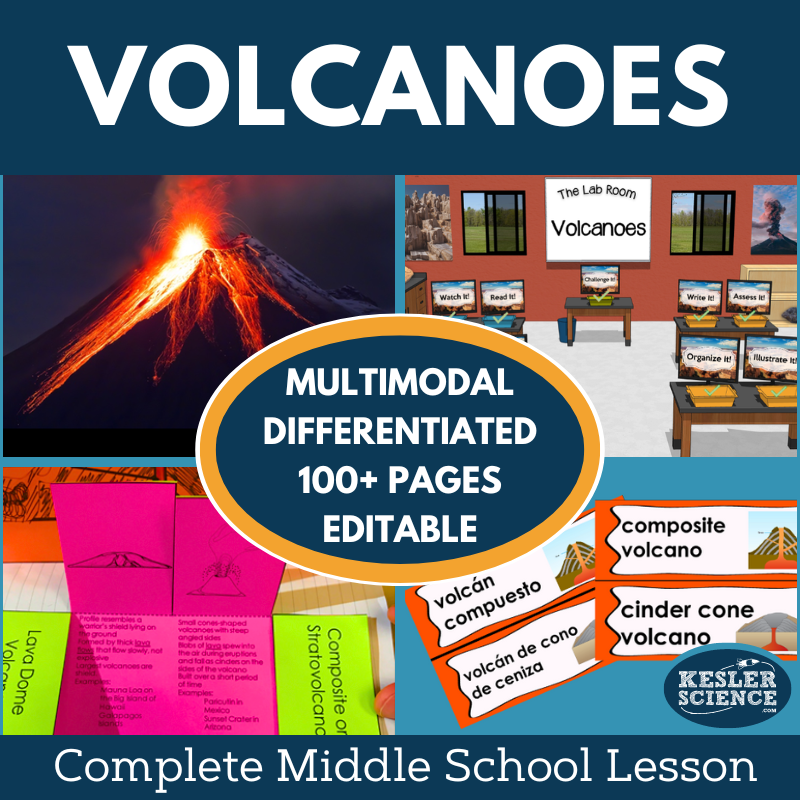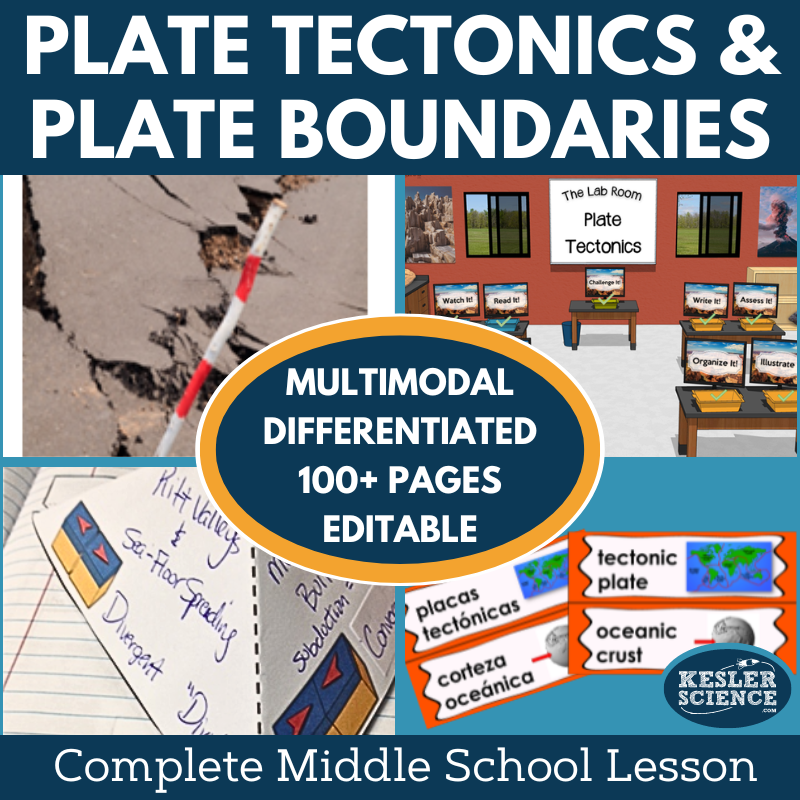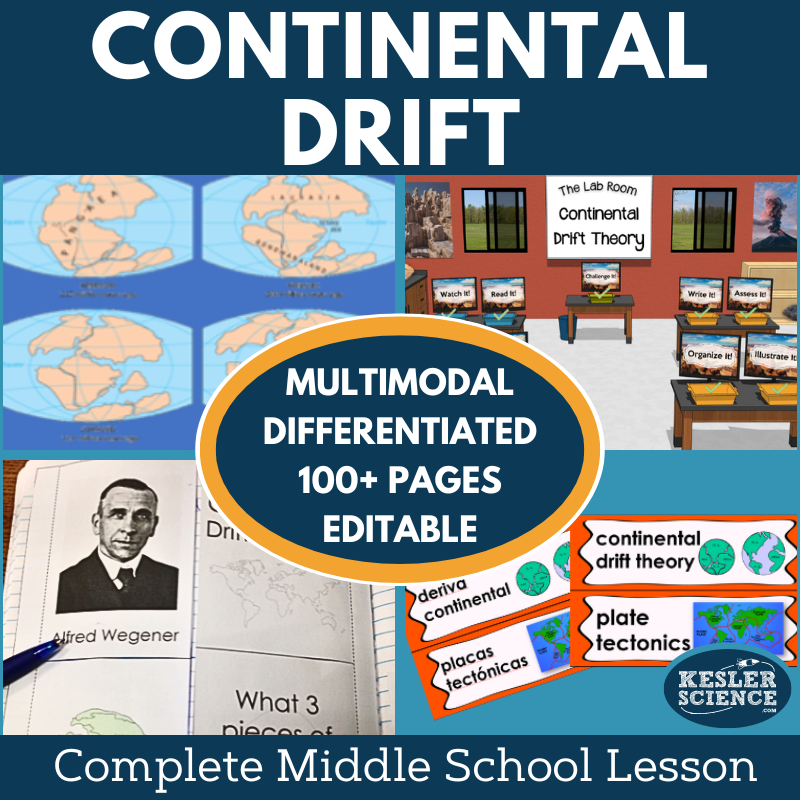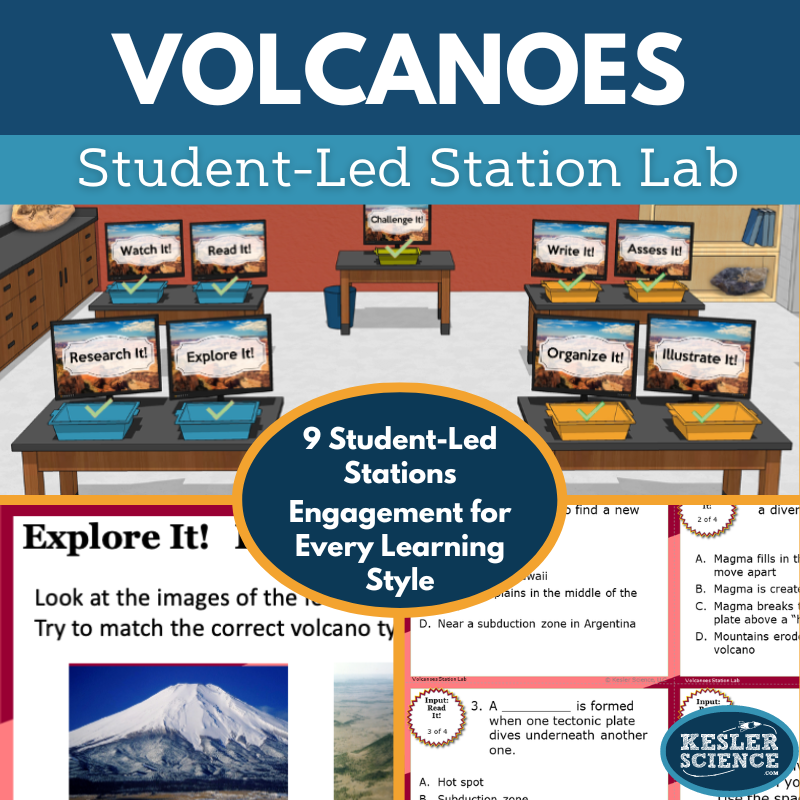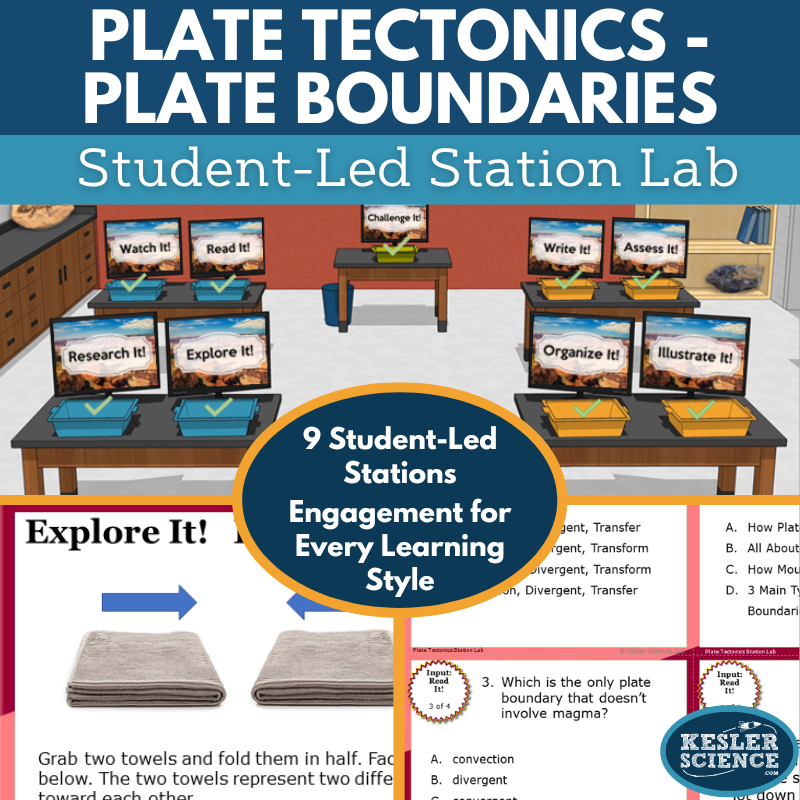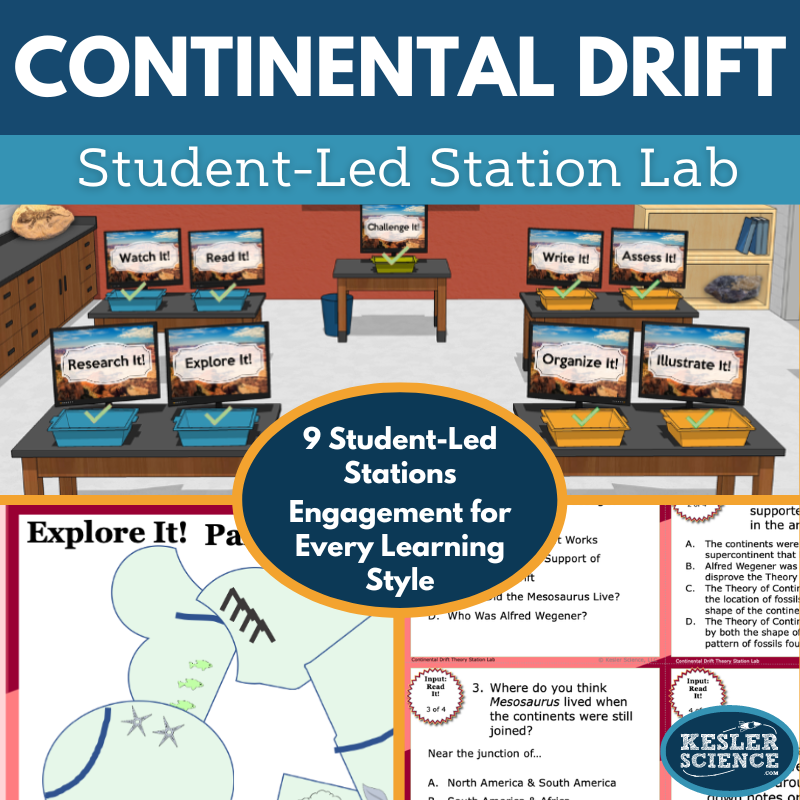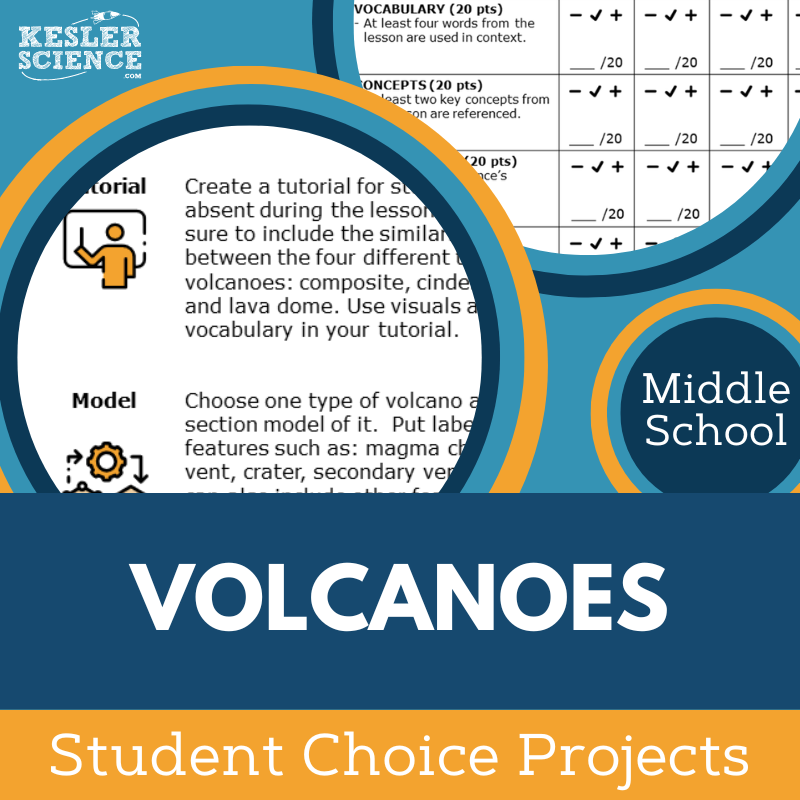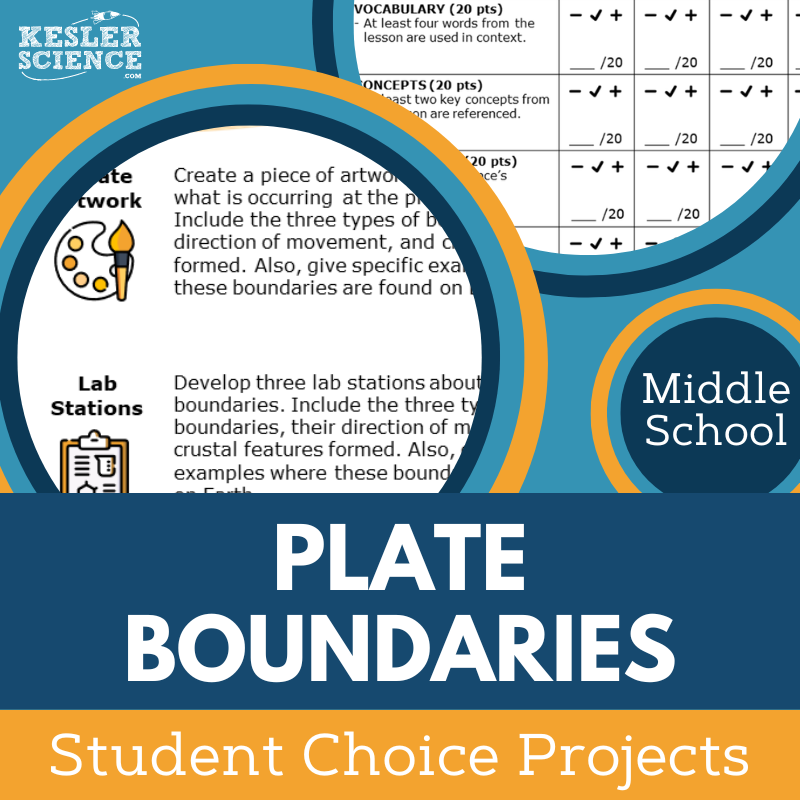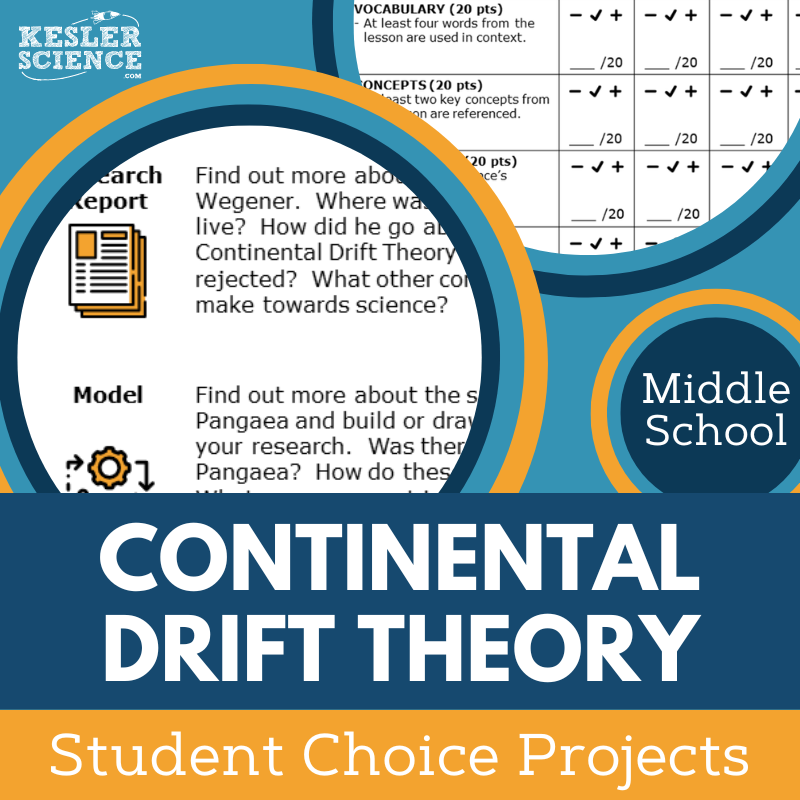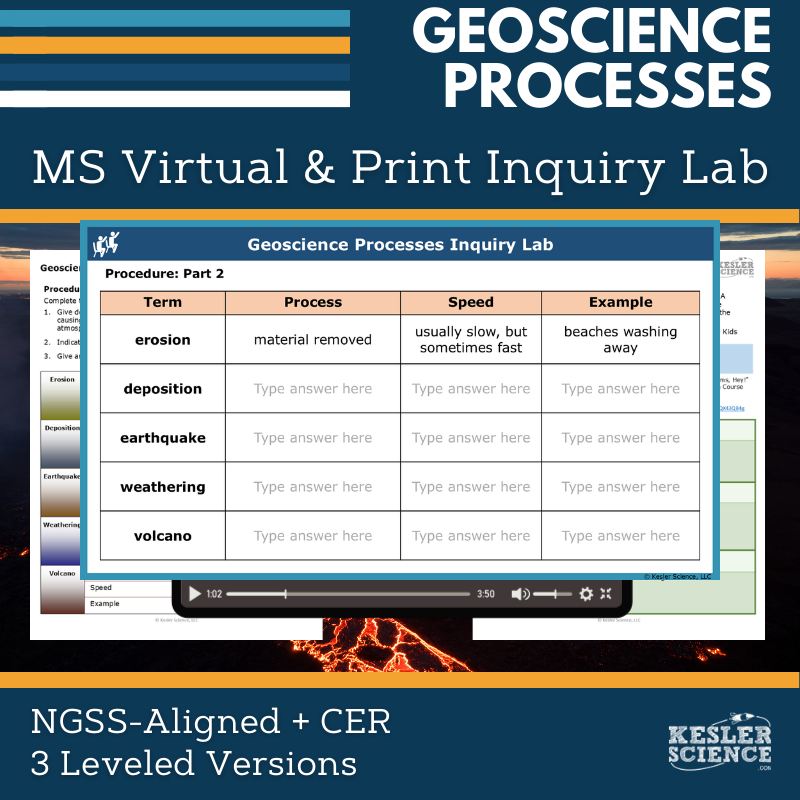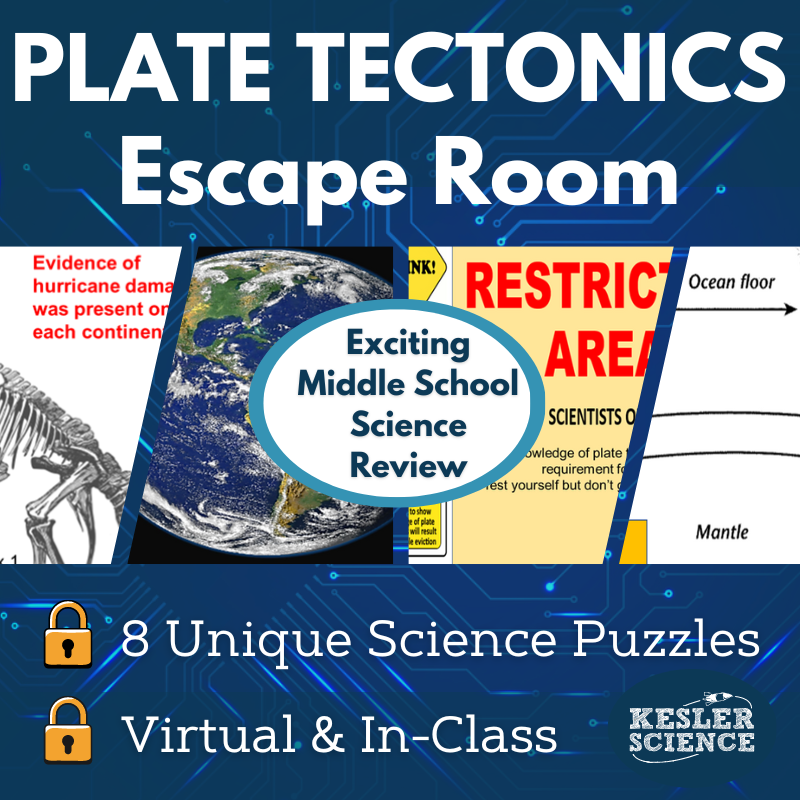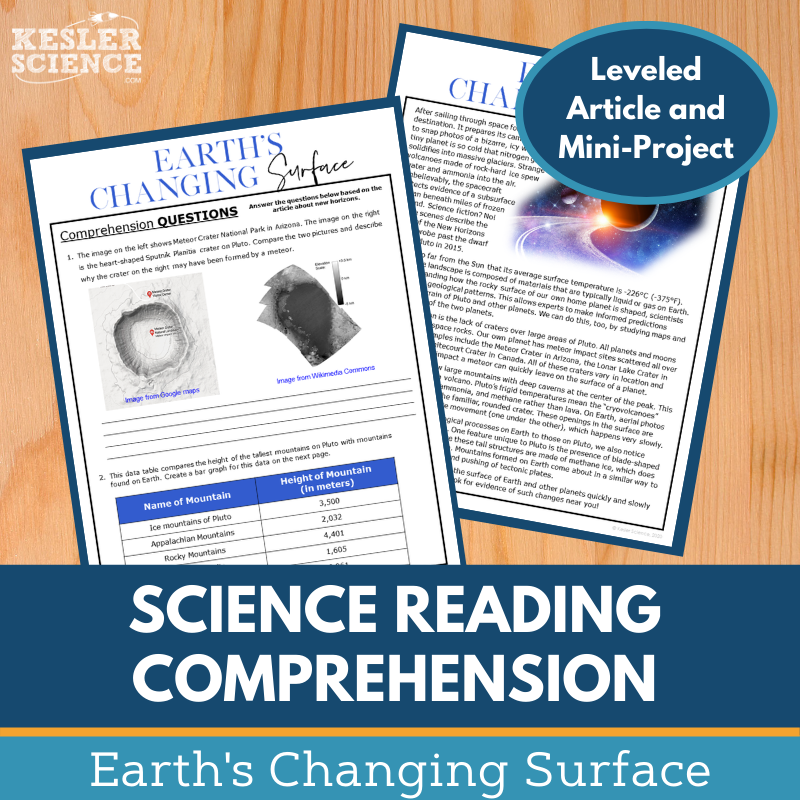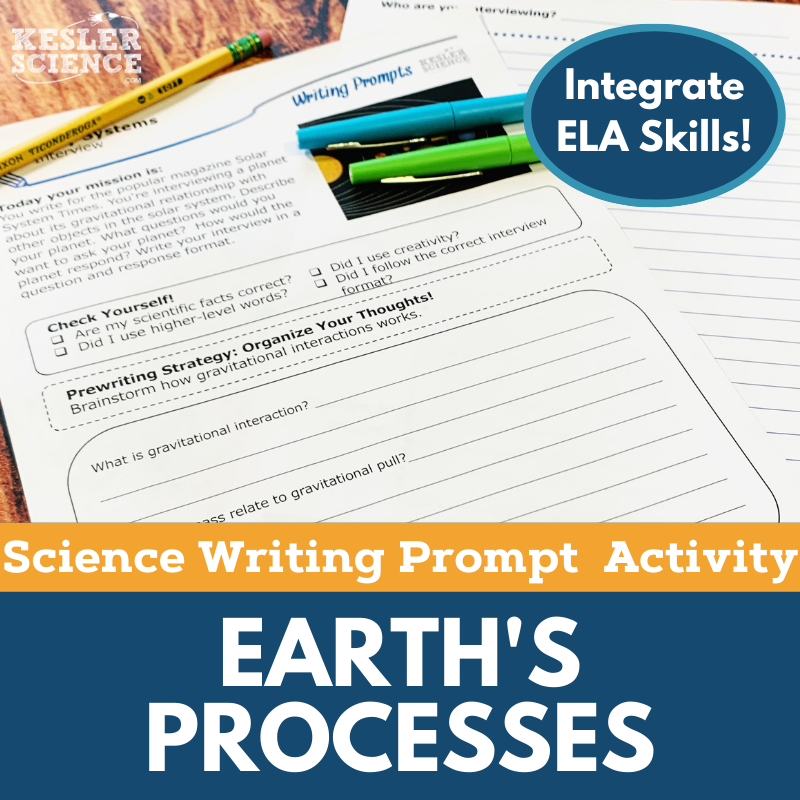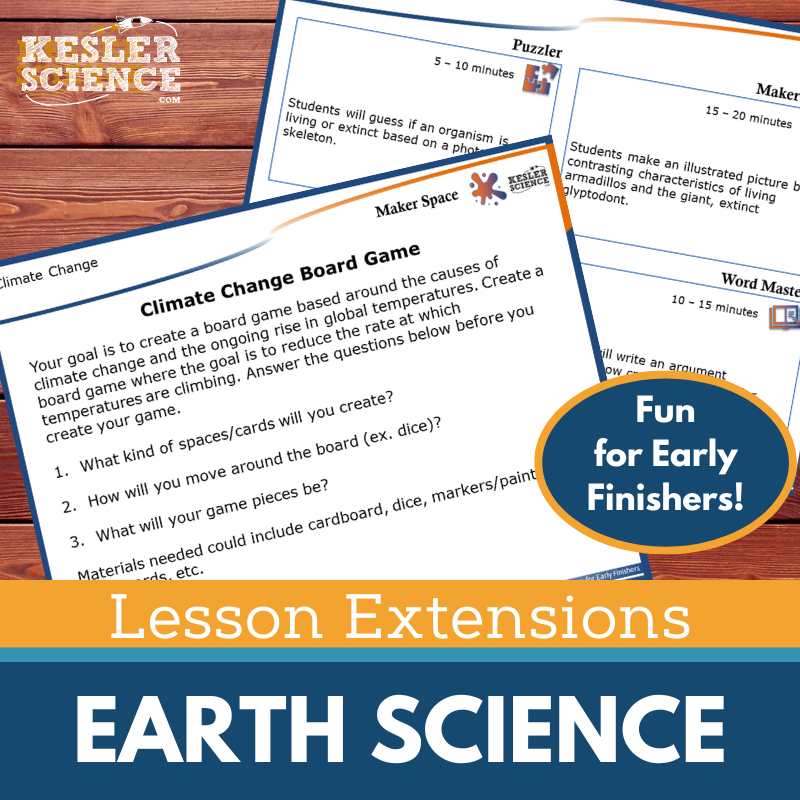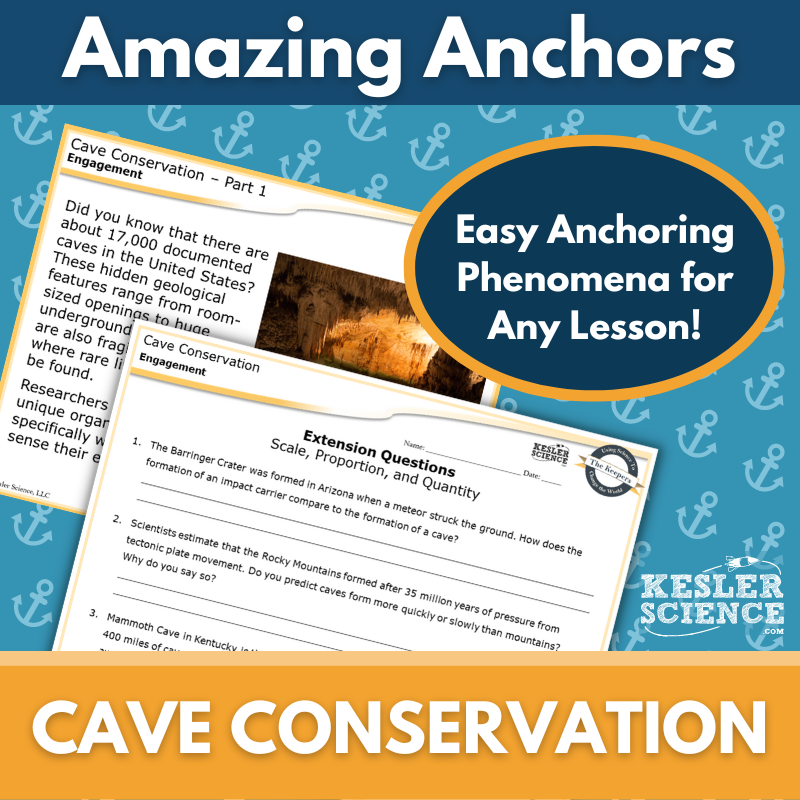Geoscience Processes Activities for Middle School Science
The Kesler Science Volcanoes, Plate Tectonics, and Continental Drift 5E Lessons engage middle school students in an interactive, student-led exploration of Earth's dynamic processes. The resources below will give students a comprehensive understanding of geoscience processes. All of the following materials are also included in the Kesler Science Membership.
The Kesler Science Volcanoes 5E Lesson is a comprehensive, student-led unit designed for middle school earth science. It includes editable presentations, worksheets, choice projects, and assessments, requiring minimal prep while offering maximum flexibility in digital and print formats. The lesson aligns with the 2021 TEKS standards and provides Spanish translations for vocabulary, reading passages, and interactive notebook pages.
Following the 5E Model, the unit begins with engagement activities such as class discussions and misconceptions. In exploration, students work through differentiated station labs featuring hands-on demos, reading comprehension, research tasks, and videos. Output stations allow students to demonstrate learning through sorting, writing, illustrating, and assessments, with an additional challenge station for enrichment. Explanation includes editable PowerPoints, interactive notebooks, and note-taking templates. Elaboration offers student-choice projects, while evaluation includes STAAR 2.0-aligned assessments and review materials.
Designed for both classroom and virtual learning, the lesson ensures accessibility for all students through multimodal strategies and differentiated content.
The Kesler Science Volcanoes 5E Lesson is a comprehensive, student-led unit designed for middle school earth science. It includes editable presentations, worksheets, choice projects, and assessments, requiring minimal prep while offering maximum flexibility in digital and print formats. The lesson aligns with the 2021 TEKS standards and provides Spanish translations for vocabulary, reading passages, and interactive notebook pages.
Following the 5E Model, the unit begins with engagement activities such as class discussions and misconceptions. In exploration, students work through differentiated station labs featuring hands-on demos, reading comprehension, research tasks, and videos. Output stations allow students to demonstrate learning through sorting, writing, illustrating, and assessments, with an additional challenge station for enrichment. Explanation includes editable PowerPoints, interactive notebooks, and note-taking templates. Elaboration offers student-choice projects, while evaluation includes STAAR 2.0-aligned assessments and review materials.
Designed for both classroom and virtual learning, the lesson ensures accessibility for all students through multimodal strategies and differentiated content.
The Kesler Science Plate Tectonics 5E Lesson is a comprehensive, student-led unit designed for middle school. It includes presentations, worksheets, choice projects, and assessments, all fully editable for flexible use. Differentiated and multimodal, the lesson engages students while minimizing teacher prep time.
Aligned with NGSS, this lesson covers key concepts such as plate tectonics, plate boundaries, and crustal features. The unit follows the 5E Model, featuring engagement activities, a hands-on exploration station lab with nine differentiated stations, and interactive PowerPoints and notebooks in English and Spanish. Students extend learning through choice projects and demonstrate understanding with updated STAAR 2.0-aligned assessments.
The resource supports virtual and in-class learning, offering printable and digital formats, Spanish translations, and editable materials.
The Kesler Science Plate Tectonics 5E Lesson is a comprehensive, student-led unit designed for middle school. It includes presentations, worksheets, choice projects, and assessments, all fully editable for flexible use. Differentiated and multimodal, the lesson engages students while minimizing teacher prep time.
Aligned with NGSS, this lesson covers key concepts such as plate tectonics, plate boundaries, and crustal features. The unit follows the 5E Model, featuring engagement activities, a hands-on exploration station lab with nine differentiated stations, and interactive PowerPoints and notebooks in English and Spanish. Students extend learning through choice projects and demonstrate understanding with updated STAAR 2.0-aligned assessments.
The resource supports virtual and in-class learning, offering printable and digital formats, Spanish translations, and editable materials.
The Kesler Science Continental Drift 5E Lesson is a comprehensive middle school unit covering Alfred Wegener’s theory and the evidence supporting continental drift. It includes editable presentations, worksheets, choice projects, and assessments, all designed for differentiated, student-led learning with minimal prep. The lesson aligns with NGSS standards and integrates multimodal learning for engagement.
Following the 5E Model, students begin with vocabulary-building and discussion-based engagement activities. The exploration phase features a differentiated station lab with nine stations, including hands-on experiments, reading passages in English and Spanish, research tasks, videos, and interactive categorization activities. Explanation resources include editable PowerPoints, interactive notebooks, and note-taking templates. Students deepen their understanding through choice projects in the elaboration phase. Evaluation includes updated STAAR 2.0-aligned assessments, review questions, and worksheets.
The lesson is fully flexible, offering digital and printable formats, Spanish translations for key materials, and virtual learning compatibility.
The Kesler Science Continental Drift 5E Lesson is a comprehensive middle school unit covering Alfred Wegener’s theory and the evidence supporting continental drift. It includes editable presentations, worksheets, choice projects, and assessments, all designed for differentiated, student-led learning with minimal prep. The lesson aligns with NGSS standards and integrates multimodal learning for engagement.
Following the 5E Model, students begin with vocabulary-building and discussion-based engagement activities. The exploration phase features a differentiated station lab with nine stations, including hands-on experiments, reading passages in English and Spanish, research tasks, videos, and interactive categorization activities. Explanation resources include editable PowerPoints, interactive notebooks, and note-taking templates. Students deepen their understanding through choice projects in the elaboration phase. Evaluation includes updated STAAR 2.0-aligned assessments, review questions, and worksheets.
The lesson is fully flexible, offering digital and printable formats, Spanish translations for key materials, and virtual learning compatibility.
Engage your middle school students with this student-led Volcanoes Station Lab, designed to foster independent learning while minimizing prep time. Through hands-on activities and multimodal resources, students will construct explanations based on evidence to understand how geoscience processes shape Earth’s surface.
This lab includes eight differentiated stations and a bonus challenge station, allowing students to explore new concepts through interactive tasks. Input stations feature hands-on demonstrations, research-based activities, reading passages (available in English and Spanish), and videos. Output stations encourage students to demonstrate their learning through organizing manipulatives, illustrating models, writing responses, and answering assessment questions.
Ideal for in-class or virtual learning, this engaging resource promotes critical thinking and active exploration of volcanoes.
Engage your middle school students with this student-led Volcanoes Station Lab, designed to foster independent learning while minimizing prep time. Through hands-on activities and multimodal resources, students will construct explanations based on evidence to understand how geoscience processes shape Earth’s surface.
This lab includes eight differentiated stations and a bonus challenge station, allowing students to explore new concepts through interactive tasks. Input stations feature hands-on demonstrations, research-based activities, reading passages (available in English and Spanish), and videos. Output stations encourage students to demonstrate their learning through organizing manipulatives, illustrating models, writing responses, and answering assessment questions.
Ideal for in-class or virtual learning, this engaging resource promotes critical thinking and active exploration of volcanoes.
Engage your middle school students in a student-led exploration of plate tectonics with this interactive station lab. Designed for independent or small-group learning, the lab helps students identify major tectonic plates through nine differentiated stations featuring videos, readings, research, hands-on activities, and assessments.
Students interact with new concepts through multimodal input stations, including hands-on demonstrations, research tasks, reading passages available in English and Spanish, and video-based learning. Output stations allow them to showcase their understanding through organizing information, sketching models, writing responses, and completing assessments. A challenge station provides extension activities for advanced learners.
This modular, low-prep resource is adaptable for both in-class and virtual learning, offering an engaging and comprehensive approach to Earth science education.
Engage your middle school students in a student-led exploration of plate tectonics with this interactive station lab. Designed for independent or small-group learning, the lab helps students identify major tectonic plates through nine differentiated stations featuring videos, readings, research, hands-on activities, and assessments.
Students interact with new concepts through multimodal input stations, including hands-on demonstrations, research tasks, reading passages available in English and Spanish, and video-based learning. Output stations allow them to showcase their understanding through organizing information, sketching models, writing responses, and completing assessments. A challenge station provides extension activities for advanced learners.
This modular, low-prep resource is adaptable for both in-class and virtual learning, offering an engaging and comprehensive approach to Earth science education.
Engage your middle school students in a student-led exploration of plate tectonics with this interactive station lab. Designed for independent or small-group learning, the lab helps students identify major tectonic plates through nine differentiated stations featuring videos, readings, research, hands-on activities, and assessments.
Students interact with new concepts through multimodal input stations, including hands-on demonstrations, research tasks, reading passages available in English and Spanish, and video-based learning. Output stations allow them to showcase their understanding through organizing information, sketching models, writing responses, and completing assessments. A challenge station provides extension activities for advanced learners.
This modular, low-prep resource is adaptable for both in-class and virtual learning, offering an engaging and comprehensive approach to Earth science education.
Engage your middle school students in a student-led exploration of plate tectonics with this interactive station lab. Designed for independent or small-group learning, the lab helps students identify major tectonic plates through nine differentiated stations featuring videos, readings, research, hands-on activities, and assessments.
Students interact with new concepts through multimodal input stations, including hands-on demonstrations, research tasks, reading passages available in English and Spanish, and video-based learning. Output stations allow them to showcase their understanding through organizing information, sketching models, writing responses, and completing assessments. A challenge station provides extension activities for advanced learners.
This modular, low-prep resource is adaptable for both in-class and virtual learning, offering an engaging and comprehensive approach to Earth science education.
The Volcanoes Student Choice Projects lesson aligns with NGSS standards, allowing middle school students to choose from six project options or create their own. A project page outlines these choices, and an editable rubric supports teacher, peer, or self-assessment.
These flexible, multimodal projects give students creative ways to demonstrate their understanding. Teachers can adjust the rubric to meet grading needs, and two versions of the project page support differentiation—one with modified options for students needing remediation and another for those seeking a challenge.
Projects require standard classroom supplies like paper, markers, and scissors, with many options available for digital completion. Some crafting materials may be useful for building models.
The Volcanoes Student Choice Projects lesson aligns with NGSS standards, allowing middle school students to choose from six project options or create their own. A project page outlines these choices, and an editable rubric supports teacher, peer, or self-assessment.
These flexible, multimodal projects give students creative ways to demonstrate their understanding. Teachers can adjust the rubric to meet grading needs, and two versions of the project page support differentiation—one with modified options for students needing remediation and another for those seeking a challenge.
Projects require standard classroom supplies like paper, markers, and scissors, with many options available for digital completion. Some crafting materials may be useful for building models.
The Plate Boundaries Student Choice Projects align with NGSS science standards, allowing middle school students to demonstrate their understanding through a project that matches their preferred output style. A project page outlines six student-led options plus a “design your own” project, with an editable rubric for teacher, peer, or self-assessment.
These flexible, multimodal projects offer creative ways for students to showcase their learning. Two versions of the project page support differentiation, with modified options for students needing remediation and challenge opportunities for advanced learners. Teachers can adjust the rubric to fit grading needs.
The projects use standard classroom supplies like paper, markers, and scissors, with many options available for digital completion. Some crafting materials may be useful for building models.
The Plate Boundaries Student Choice Projects align with NGSS science standards, allowing middle school students to demonstrate their understanding through a project that matches their preferred output style. A project page outlines six student-led options plus a “design your own” project, with an editable rubric for teacher, peer, or self-assessment.
These flexible, multimodal projects offer creative ways for students to showcase their learning. Two versions of the project page support differentiation, with modified options for students needing remediation and challenge opportunities for advanced learners. Teachers can adjust the rubric to fit grading needs.
The projects use standard classroom supplies like paper, markers, and scissors, with many options available for digital completion. Some crafting materials may be useful for building models.
The Continental Drift Theory Student Choice Projects align with NGSS science standards, allowing middle school students to select a project that suits their preferred output style. A project page outlines six student-led options plus a “design your own” project, all with an editable rubric for teacher, peer, or self-assessment.
These flexible, multimodal projects provide creative ways for students to demonstrate their understanding. Teachers can adjust the rubric to fit grading needs, and two versions of the project page support differentiation. The modified version includes three project options designed for students needing remediation, while advanced learners can be challenged with multiple projects using the same rubric.
The projects use standard classroom supplies such as paper, markers, and scissors, with many options available for digital completion. Some crafting materials may be useful for model-building.
The Continental Drift Theory Student Choice Projects align with NGSS science standards, allowing middle school students to select a project that suits their preferred output style. A project page outlines six student-led options plus a “design your own” project, all with an editable rubric for teacher, peer, or self-assessment.
These flexible, multimodal projects provide creative ways for students to demonstrate their understanding. Teachers can adjust the rubric to fit grading needs, and two versions of the project page support differentiation. The modified version includes three project options designed for students needing remediation, while advanced learners can be challenged with multiple projects using the same rubric.
The projects use standard classroom supplies such as paper, markers, and scissors, with many options available for digital completion. Some crafting materials may be useful for model-building.
The Geoscience Processes Inquiry Lab aligns with NGSS MS-ESS2-2, helping students construct explanations based on evidence of how Earth’s surface changes due to weathering, erosion, deposition, earthquakes, or volcanic activity. This lab includes both hands-on print and interactive digital versions, each with comprehension questions, Claim-Evidence-Reasoning (C.E.R.) prompts, and reflection sections.
The lab is differentiated into three levels to accommodate diverse learning needs. The dependent version provides guided inquiry questions, the modified version offers structured support with sentence stems and multiple-choice options, and the independent version allows advanced learners to take charge of their investigations. Students will make observations, analyze images of geoscience processes, and create a concept map of Earth’s surface changes.
The print format includes a hands-on experiment where each student completes their own sheet, while the digital format is an interactive PowerPoint compatible with Google Slides, MS Teams, Schoology, and Canvas. No materials are required for the virtual version, making it accessible for students without supplies or those absent from class.
Editable teacher resources include answer keys, standards and objectives, estimated prep time, teacher directions, and additional materials. The flexible design allows customization to fit classroom needs, ensuring an engaging and comprehensive exploration of Earth's dynamic surface.
The Geoscience Processes Inquiry Lab aligns with NGSS MS-ESS2-2, helping students construct explanations based on evidence of how Earth’s surface changes due to weathering, erosion, deposition, earthquakes, or volcanic activity. This lab includes both hands-on print and interactive digital versions, each with comprehension questions, Claim-Evidence-Reasoning (C.E.R.) prompts, and reflection sections.
The lab is differentiated into three levels to accommodate diverse learning needs. The dependent version provides guided inquiry questions, the modified version offers structured support with sentence stems and multiple-choice options, and the independent version allows advanced learners to take charge of their investigations. Students will make observations, analyze images of geoscience processes, and create a concept map of Earth’s surface changes.
The print format includes a hands-on experiment where each student completes their own sheet, while the digital format is an interactive PowerPoint compatible with Google Slides, MS Teams, Schoology, and Canvas. No materials are required for the virtual version, making it accessible for students without supplies or those absent from class.
Editable teacher resources include answer keys, standards and objectives, estimated prep time, teacher directions, and additional materials. The flexible design allows customization to fit classroom needs, ensuring an engaging and comprehensive exploration of Earth's dynamic surface.
The Plate Tectonics Escape Room is an interactive activity that allows students to explore plate tectonics and Wegener's continental drift theory in an engaging way. Designed to align with NGSS standards MS-ESS2-2 and MS-ESS2-3, this escape room challenges students to construct explanations based on geoscience evidence and analyze data related to fossils, rock distribution, and seafloor structures.
Teachers have full control over the eight independent puzzles, choosing which to use and in what order, making the activity adaptable for different class lengths. The escape room can be conducted using simple materials like manila envelopes or a more immersive setup with locks, a lockout hasp, and a storage box. A digital version is available via PowerPoint or Google Slides, allowing students to interact with questions and images online. A printable version can also be assigned for at-home learning.
This resource includes teacher directions, a detailed answer key, digital and printable student versions, a digital answer sheet via Google Forms, a video challenge, and eight unique puzzles with all necessary printable props. Also included are reward templates, over 50 prize ideas, and 30 unique signs for a fun photo finish.
The Plate Tectonics Escape Room is an interactive activity that allows students to explore plate tectonics and Wegener's continental drift theory in an engaging way. Designed to align with NGSS standards MS-ESS2-2 and MS-ESS2-3, this escape room challenges students to construct explanations based on geoscience evidence and analyze data related to fossils, rock distribution, and seafloor structures.
Teachers have full control over the eight independent puzzles, choosing which to use and in what order, making the activity adaptable for different class lengths. The escape room can be conducted using simple materials like manila envelopes or a more immersive setup with locks, a lockout hasp, and a storage box. A digital version is available via PowerPoint or Google Slides, allowing students to interact with questions and images online. A printable version can also be assigned for at-home learning.
This resource includes teacher directions, a detailed answer key, digital and printable student versions, a digital answer sheet via Google Forms, a video challenge, and eight unique puzzles with all necessary printable props. Also included are reward templates, over 50 prize ideas, and 30 unique signs for a fun photo finish.
This Science Reading Comprehension Passage explores Earth's changing surface through the lens of the New Horizons space probe’s flyby of Pluto. Students read a nonfiction article, answer comprehension questions, and create a model demonstrating how a planet’s surface changes when impacted by a meteor.
Designed for grades 6-8 (with higher-level 5th graders in mind), the resource includes two leveled articles (Lexile 1100-1300), five to seven comprehension questions, and a hands-on mini-project. A Cornell notes template is provided, and the passage features engaging graphics that print well in grayscale.
This resource is suitable for virtual and in-person learning, with files compatible with Google Classroom, MS Teams, Schoology, and Canvas. Students can complete assignments digitally using an editable PPT or Google Slides. Ideal for sub plans, extra credit, ISS, or whole-class instruction, this lesson fosters science literacy, reading comprehension, and critical thinking while encouraging classroom discussions.
This Science Reading Comprehension Passage explores Earth's changing surface through the lens of the New Horizons space probe’s flyby of Pluto. Students read a nonfiction article, answer comprehension questions, and create a model demonstrating how a planet’s surface changes when impacted by a meteor.
Designed for grades 6-8 (with higher-level 5th graders in mind), the resource includes two leveled articles (Lexile 1100-1300), five to seven comprehension questions, and a hands-on mini-project. A Cornell notes template is provided, and the passage features engaging graphics that print well in grayscale.
This resource is suitable for virtual and in-person learning, with files compatible with Google Classroom, MS Teams, Schoology, and Canvas. Students can complete assignments digitally using an editable PPT or Google Slides. Ideal for sub plans, extra credit, ISS, or whole-class instruction, this lesson fosters science literacy, reading comprehension, and critical thinking while encouraging classroom discussions.
The Earth’s Processes Science Writing Prompt Activity engages middle school students in a creative news event reporting exercise to reinforce their understanding of geoscience processes. Aligned with NGSS MS-ESS2-2, this activity helps students construct explanations based on evidence of how Earth's surface changes over time and at different spatial scales. Designed for both in-person and virtual learning, it supports science reasoning and writing skills in an engaging, student-centered format.
This resource includes teacher directions with an answer guide, project ideas, and rubrics, along with projection and print-friendly handouts in both full and half-sheet formats. A digital interactive PowerPoint version, compatible with Google Slides, allows for easy virtual assignments. Ideal for cross-curricular activities, pre-test assessments, student choice projects, differentiation, and more, this writing prompt fosters creativity and scientific literacy while encouraging students to showcase their work through bulletin board displays or personal anthologies. Note: These prompts are intended for review and assume prior knowledge or access to research materials.
The Earth’s Processes Science Writing Prompt Activity engages middle school students in a creative news event reporting exercise to reinforce their understanding of geoscience processes. Aligned with NGSS MS-ESS2-2, this activity helps students construct explanations based on evidence of how Earth's surface changes over time and at different spatial scales. Designed for both in-person and virtual learning, it supports science reasoning and writing skills in an engaging, student-centered format.
This resource includes teacher directions with an answer guide, project ideas, and rubrics, along with projection and print-friendly handouts in both full and half-sheet formats. A digital interactive PowerPoint version, compatible with Google Slides, allows for easy virtual assignments. Ideal for cross-curricular activities, pre-test assessments, student choice projects, differentiation, and more, this writing prompt fosters creativity and scientific literacy while encouraging students to showcase their work through bulletin board displays or personal anthologies. Note: These prompts are intended for review and assume prior knowledge or access to research materials.
Lesson Extensions provide engaging, student-choice activities that challenge early finishers while reinforcing critical thinking and creativity. Designed to enhance earth science lessons, these activities align with NGSS and TEKS standards, offering a meaningful way to scaffold learning, fill downtime, and maintain student engagement.
Each Lesson Extension includes four interactive components: Puzzler for problem-solving, Maker Space for hands-on STEAM activities, Tech Connection for digital demonstrations, and Word Master for creative writing. With teacher directions, answer keys, and both print and projection versions, these extensions support independent learning and lesson wrap-ups.
Covering topics such as climate change, plate tectonics, the fossil record, mineral properties, and geological time scales, Lesson Extensions provide rigorous yet enjoyable challenges that encourage deeper exploration of earth science concepts.
Lesson Extensions provide engaging, student-choice activities that challenge early finishers while reinforcing critical thinking and creativity. Designed to enhance earth science lessons, these activities align with NGSS and TEKS standards, offering a meaningful way to scaffold learning, fill downtime, and maintain student engagement.
Each Lesson Extension includes four interactive components: Puzzler for problem-solving, Maker Space for hands-on STEAM activities, Tech Connection for digital demonstrations, and Word Master for creative writing. With teacher directions, answer keys, and both print and projection versions, these extensions support independent learning and lesson wrap-ups.
Covering topics such as climate change, plate tectonics, the fossil record, mineral properties, and geological time scales, Lesson Extensions provide rigorous yet enjoyable challenges that encourage deeper exploration of earth science concepts.
This NGSS-aligned Amazing Anchors Phenomenon Lesson introduces and reinforces cave formation through real-world connections. It includes an introductory reading centered on the National Speleological Society, with comprehension and extension questions to prepare students for further learning. An explanatory reading breaks down the science behind cave formation and conservation, supported by additional comprehension and reinforcement questions.
Designed to bookend a lesson, this resource includes teacher directions, answer keys, projection slides, and both digital and print formats. A differentiated version provides sentence starters for student support. This engaging resource aligns with NGSS standard MS ESS2-2 and is ideal for the Engagement and Elaborate segments of 5E lessons, making it a valuable supplement for in-person or digital classrooms.
This NGSS-aligned Amazing Anchors Phenomenon Lesson introduces and reinforces cave formation through real-world connections. It includes an introductory reading centered on the National Speleological Society, with comprehension and extension questions to prepare students for further learning. An explanatory reading breaks down the science behind cave formation and conservation, supported by additional comprehension and reinforcement questions.
Designed to bookend a lesson, this resource includes teacher directions, answer keys, projection slides, and both digital and print formats. A differentiated version provides sentence starters for student support. This engaging resource aligns with NGSS standard MS ESS2-2 and is ideal for the Engagement and Elaborate segments of 5E lessons, making it a valuable supplement for in-person or digital classrooms.
Year-Round Resources
These year-round activities will increase your students' understanding of many middle school science topics. All of these activities are also included in the Kesler Science Membership.
Visual Data & Graphing
You're not alone if your students struggle with understanding graphs, charts, and tables. It's a skill that takes an enormous amount of practice. This resource will help students build a strong foundation in analyzing data and creating their own data visualizations.
Bell Ringers and Warm-Ups
These middle school science bell ringers are an excellent way to engage your students as soon as they walk into your classroom. This comprehensive FULL YEAR resource includes everything you need to start off each science class with an interesting warm-up activity.
Review Board Games
Each game board has been carefully designed to keep students engaged. There are 10 different action spaces on each board and dozens of question cards. All of the actions are related to science concepts and keep the students motivated throughout the game.
Each game is ready to play. Simply print out the board and the cards and let the students enjoy reviewing nine different units.
Essential Questions and Standards
Below are the essential questions and standards associated with the lessons and activities included in the geoscience processes unit. This topic is only one of more than 100 middle school science topics included in the Kesler Science Membership.
-
What are the parts of a volcano?
-
What are the four types?
-
What processes form volcanoes?
-
Where are volcanoes located on Earth?
-
What is plate tectonics?
-
What are the three types of plate boundaries?
-
What crustal features are formed at plate boundaries?
-
Who was Alfred Wegener?
-
What is the historical evidence that supports the Continental Drift Theory?
-
What causes the movement of the continents?
-
NGSS - MS-ESS2-2 Geoscience Processes
Kesler Science Membership
Imagine never having to search for another middle school science lesson again. The membership gives you access to ALL of the Kesler Science products in one place (Yes, including everything above).
Say goodbye to long hours of lesson prep.

